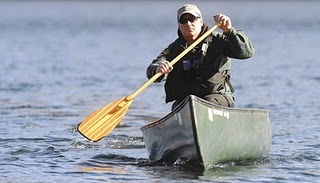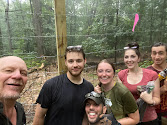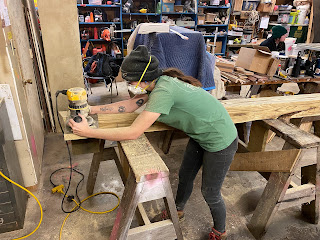The Hawk Mountain Sanctuary Stewardship Department seeks Seasonal Sanctuary Stewards for field seasons from May through August. Following are the written accounts of four outstanding Stewards from the past 2023 season.
Caroline Fegley – stewardship blog 2023
After earning a bachelor’s degree, the outside world was pressuring me to attend graduate school, but how was I supposed to commit to a career field without experiencing every option first? Since 2021, I’ve spent seasons as a raptor researcher, educator, and this year a stewardship technician searching for whichever path was right for me.This past winter while working on a mural for Todd Bauman, I asked him if I could join his stewardship team for the summer. I knew it would be tough, and to join the crew I had to be ready for hardcore workdays but spending work in the woods seemed infinitely better than a desk. Within the first week, I’d used more new tools and skills than I could count to help timber-frame an info kiosk at the main trailhead. After four years of weightlifting and rock climbing, I thought I was strong, but at times could barely keep up with Brandie lifting and throwing wooden beams onto the workbench. Could I match my crew’s pace for the entire season?
It was a dry spring with the first big rain happening the first few days of May. We used the opportunity to complete salamander surveys on several plots established throughout Hawk Mountain and Weiser State Forest. This was my element. Trekking around the mountain, we timed ourselves for 10 minutes at every plot and tried to flip over as many rocks and logs as we could, looking for signs of small amphibians. While replacing old flags around the perimeters, I would point out the fresh songbird migrants to Brandie, honored to witness the tiny creatures resting amidst their immense journeys.
Over the next several weeks, our crew watched as the forest came alive with new plants and animals. We were ecstatic to have our favorite places filled with creatures we’d missed all winter; however, a new enemy was beginning to take force against us. The biggest challenge the stewardship crew faces is removing invasive plants to restore natural habitat and maintain it for years to come. Unfortunately, due to human movement, we carry and spread invasive species capable of decimating entire ecosystems. To keep Hawk Mountain a safe place for local and migrant wildlife, nurturing the native plants is imperative. My days quickly turned into 8 hours of focusing on leaves and flowers to swiftly decide if a plant deserved to die by the wrath of the weed-whacker. By the end of each night, my eyes would close, and imagery of hundreds of garlic mustard plants would flash through my head.
Mid-season my hope started to waver as to whether our efforts made any difference in the ecosystems we were trying so hard to protect. At the end of each shift, I struggled to give my body enough calories to sustain the next day’s tasks before hitting my pillow and being thrown into a night’s sleep. I wasn’t sure it was possible to reach our goals with a crew of only several people, even though we were putting 100% of our available energy into the cause. It was then that I was taken for the first time to the Cerulean Enclosure, built to protect a portion of land from being over-browsed by hungry deer. Inside the fence, native plant species I’d never had the chance to encounter were thriving. Only a short time ago, that same land was struggling to win the fight against invasives, but with the help of the crew’s many hours of hand-weeding, the natural ecosystem was healed. My crew felt like children on Christmas morning, running around with our phones to identify plants brand new to our eyes. It was clear our efforts were worth it.
My season began in search for an answer to which conservation path was right for me. After a few months I got my answer: all of them. Without research, you cannot educate; without education, you cannot engage research; and without stewardship, you cannot protect or nurture the ecosystems you’re trying to research and educate about. Every conservation path is intertwined and equally important to the overall cause.
Kate George-Stewardship Blog 2023
A day in the life of a Land Steward at Hawk Mountain Sanctuary
My day begins at 8:00am sharp. As a team, we meet and debrief the plans for the day. After that, we promptly depart to meet at the shed also known as "der schuppe". The shed holds all the tools for our success: saws, watering cans, shovels, sledgehammers, drills, paint. At this point our tasks could vary quite a bit from day to day. Some mornings are spent driving the golf cart to go water the blueberries planted on the North Lookout Trail. The blueberries were planted to restore wildlife habitat on the forest floor. Other mornings are spent digging holes to put up posts for deer exclosures. A deer exclosure is an area protected against deer to allow native plants to grow and thrive. We usually take a break around noon and eat some lunch.
Later in the season, we spend most of the day spraying invasive weeds with a backpack sprayer. Invasive weed management is a very important focus for Hawk Mountain. Without management, the invasive weeds and shrubs can take over the forest’s understory, preventing native plants to flourish and thrive. We mainly target stilt grass and smart weed with the sprayer and hand-pull other invasives such as crown-vetch, mile-a-minute, mugwort, bindweed, barberry, and garlic mustard.
While managing invasives in the middle of the forest, you can really get lost in the beauty of the woods that surround you. My favorite part of my day is seeing first-hand some of the coolest flora and fauna in their natural habitats. My favorites include a red eft, wood frog, white-tail deer, timber rattlesnake, sensitive fern, rattlesnake plantain, and coral fungus. It is amazing what you can find living on the forest floor once you really stop and pay attention. I highly recommend to anyone to just take a moment outside, slow down, and just observe the mass amount of life that is happening below your feet.
At about 4:00 we end up packing it up for the day. We head back to the shed to rinse out our sprayers and go home. Although I am usually exhausted and fatigued by the end of the day, I always leave with a sense of fulfillment and satisfaction from all the hard work we accomplished. I wouldn’t have it any other way.
Abigail Ide-Stewardship Blog 2023
This job is no picnic. I regularly trip over logs, slip on rocks, and take the occasional fall. I’ve been bit by itchy chiggers, buzzing mosquitos, poppyseed-sized ticks. There were days when I held my breath cleaning the composting toilets. Days I’d start spraying at five in the morning by the light of headlamps just to avoid the heat of the day. Days where I’d climb the two and a half miles ascend up the ridge with a forty-five-pound backpack. And another day or two I’d clock out with my lower back stained blue from a leaking sprayer. Those are the days I would question if it’s worth it. I could be making the same fifteen dollars an hour stocking shelves somewhere dry and airconditioned. And still I stay here.
I’ve never left a shift feeling unfulfilled. Areas that were once seas of stilt grass and blockades of barberry were cleared for new growth because of me. Areas devoid of old growth will have a fighting chance because of me. Trails are no longer trenched nor unsafe because of me. But I didn’t do it alone. This job would be impossible if it weren’t for the dedicated team of stewards here at Hawk Mountain. We all left some days soaking wet yet smiling and that’s what makes me come back after those bad days. Packing four stewards on the front of a golf cart just to water blueberries. Laughing at Todd’s childhood stories over a Stromboli sandwich till I wheeze makes those bad days not so bad. Seeing tiny native sprouts poking through the leaf litter brings a smile to my face. And the occasional surprise of a shy box turtle, a curious deer, or a racing snake make our day here.
I’ll be leaving my first season here in a few days and it was the best job I’ve ever had. Being able to see the fruits of our labor now and knowing somebody, if not my returning self, will carry on my effort next year is special. Collecting data for collaborative research projects, becoming a certified pesticide technician, and learning to operate a front loader and backhoe are only a handful of invaluable skills I only have this job to thank for.
So, thank you Hawk Mountain. KJB-211, Abby clear.
Brandie Garner – Stewardship blog 2023
When I first started working at Hawk Mountain Sanctuary, I thought that I had everything planned out. I was going to work a summer position, gain experience and knowledge while continuing to move forward with my goals in environmental science. I didn’t realize how quickly I’d fall in love with this place and the people here. Even though this is one of the most physically challenging places I’d ever worked, by the end of that first summer season I knew this was where I wanted to be.
At first I thought working here on the mountain would just be an easy summer position with the added perk of working outside but I was quickly proven wrong. That first season I was immediately hit with intense summer heat and humidity all while carrying a 45lb backpack sprayer up and down rocky hills. To this day it is something that I haven't gotten used to and according to my coworkers you never do. At first, the amount of invasive species covering the forest floor was overwhelming and discouraging. It didn’t seem possible to accomplish the goals my supervisors set for the department. Though we still have a long way to go, after three years here I can confidently say that is not the case.
During my first year as a sanctuary steward I remember standing at the top of our leading edge; looking down at a sea of Japanese stilt grass as far as the eye can see. Every year we spend most of our summers focusing on that area, with it being one of the main spots for invasives enter our forest interior. As we moved to other areas of our leading edge and I saw similar scenes I couldn’t help but feel discouraged.
Three summers ago, we built a 2.5 acre deer exclosure in an area that used to be covered in Japanese barberry and Japanese stilt grass. The number of post holes we had to dig was… one too many. It didn’t help that half of the time there were huge rocks stopping you from digging further so you either had to move to a different spot or it was time to pull out the big rock bar. As challenging as that all seems it wasn’t even the hardest part. Now, with all the work I’ve done I like to think that I'm pretty strong but nothing shows you the truth more than having to carry 8 foot poles down a rocky, uneven mountain. While it wasn’t fun, I have to admit that I was impressed with myself once we got all of the poles to their locations.
With the help of our “Ye Olde Fence Stretcher” (and the amazing circus-like teamwork between Steve and Vinny) we were able to finish the exclosure. At the end of the day all that work was really worth it. The exclosure went from being an open sea of stilt grass to a fenced-in oasis bursting with a plethora of native flora. This area is filled with so many natives that there’s even some that aren’t really found on other parts of the mountain. It can be difficult and stressful avoiding native plants while spraying so it is nice that this area is now able to be hand pulled.
This past year I was tasked with designing and installing signage identifying each of our drainages in the leading edge and now it is much easier to be more efficient with our spraying. A pack that used to take roughly 30 minutes to empty is now taking almost two hours in this area because now we have to walk further in the mountain in search of invasive plants. In that area we constructed 10 mini deer exclosures and planted over 500 trees. It’s a great feeling that one day I'll be able to see grown trees and know that I helped make that happen. We were able to provide multiple areas for our Pennsylvania natives to flourish and I am proud of that.
Being able to look back each year and see the difference we are making on the mountain is both inspiring and motivating. It helps to work with people who honestly care for the mountain as their passion is contagious and inspires you to genuinely care about the mountain, the plants and animals that call it home, and all of the work we do. Not only am I seeing changes on the mountain but I’m also seeing them in myself.
Before I started in the Stewardship Department here at Hawk Mountain, I had a general understanding of how basic tools work like a hammer and screw gun. However, having the full trust of my supervisors gave me the confidence to work on and obtain skills well beyond that. I can now say that I have and can effectively use power sanders, almost every type of saw there is, gas powered compactors, chainsaws, diesel tractors, just to name a few. Over the past three years I’ve become quite skilled in using wood routers and have now been designated by my department as the go to person for routing signs. Learning these skills has given me the opportunity to work on projects like timber framing our new trailside kiosk, building planting tables for our wonderful Native Habitat Garden volunteers and so much more.
Over the last three years I’ve learned so many things and developed various skills that I know will benefit me not only in future career opportunities but also in everyday life. I’ve led crew members on various adventures through the forest; ranging from surveying wildlife to tackling the aggressive barberry fields in the forest interior... one of my favorite things we do on the mountain and possibly the most satisfying. Over the course of my time here I have gained so much knowledge on our native and invasive species and I look forward to learning more. I am proud to be a part of the changes here on the mountain and excited to be a part of what comes next.
https://www.youtube.com/watch?v=yhLKKHmhmUA&t=39s
https://www.youtube.com/watch?v=AzStq3n7XF8
https://www.youtube.com/watch?v=qATQSeiis9o
https://www.youtube.com/watch?v=BtxigH1NeU8
























